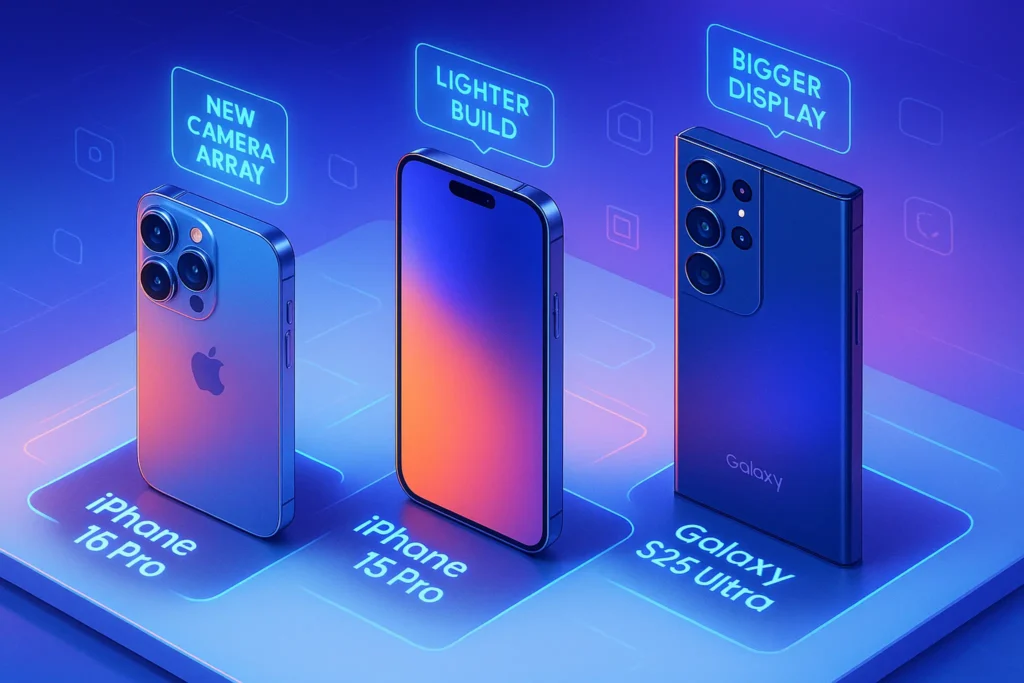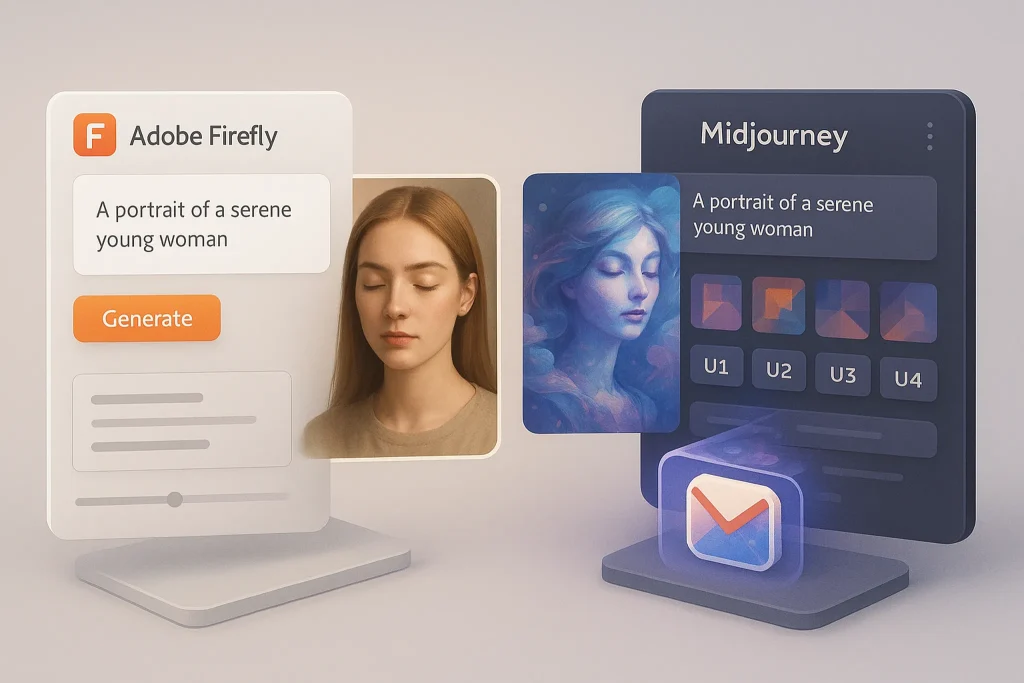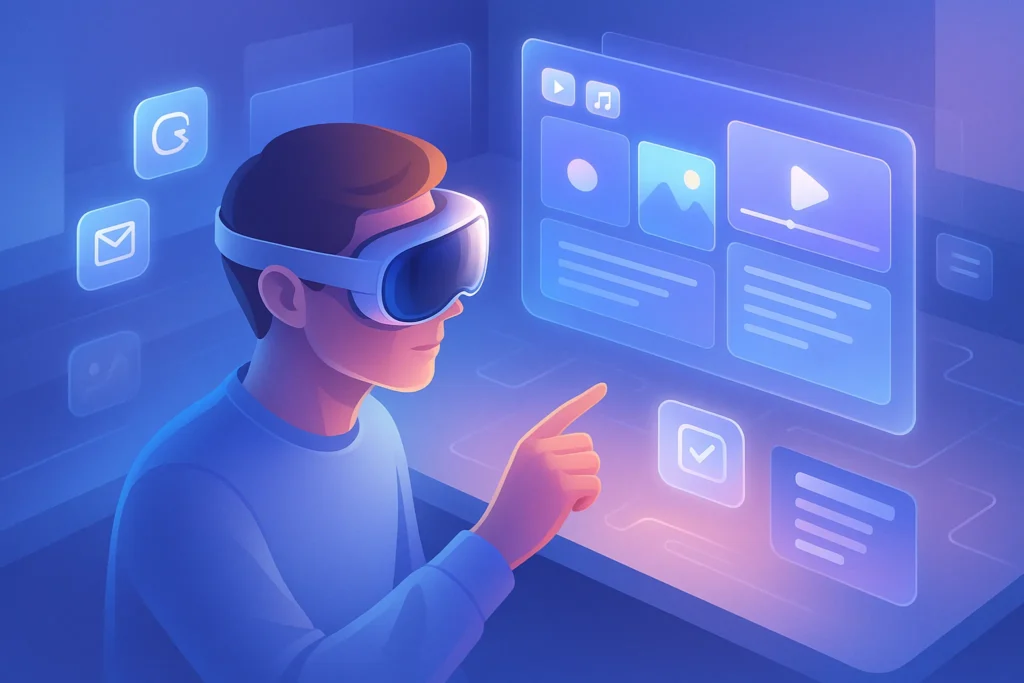-This post may contain affiliate links. If you click on one and make a purchase, I may earn a small commission at no extra cost to you.-
📱 iPhone 16 Pro Review: The Good, The Bad, and Is It Worth It?
Apple’s iPhone 16 Pro has officially landed, and as expected, it’s making waves. With a bigger display, upgraded camera system, and the debut of Apple Intelligence, this device promises to be more than just an incremental upgrade. But is it truly worth the $999+ price tag?
In this deep-dive review, we’ll explore the strengths, weaknesses, and real-world value of the iPhone 16 Pro. Whether you’re upgrading from an older iPhone or deciding between the 16 Pro and its competitors, this guide will help you make an informed decision.
With its new Liquid Glass finish, upgraded A19 chip, and a camera system that’s inching closer to DSLR territory, Apple claims it’s “the most pro iPhone ever.”
But the question remains: is this $1,199 device a worthy upgrade—or is it another year of safe iteration?
Let’s unpack the real-world experience of using the iPhone 16 Pro—warts and all.
🧊 Where It Sits in Apple’s 2025 Lineup
Before we dive into the nitty-gritty, it’s important to understand where the 16 Pro sits in the current iPhone ecosystem. With the introduction of iOS 26 and Apple’s growing push toward ecosystem lock-in with Vision Pro, the 16 Pro is clearly aimed at users who want deep, seamless integration with Apple’s entire product suite.
It’s not just another phone—it’s a hub for your Apple life. But that doesn’t mean it’s for everyone.
✅ The Good: What Makes the iPhone 16 Pro Shine
📐 1. Bigger, Better Display
- Size: 6.3-inch Super Retina XDR OLED
- Refresh Rate: Adaptive 1–120Hz ProMotion
- Brightness: Up to 2,000 nits outdoors
Apple has slimmed down the bezels, giving the iPhone 16 Pro a larger screen without making the device feel bulky. The display is crisp, vibrant, and ideal for gaming, streaming, and productivity.
On paper, not much has changed:
-
6.1” Super Retina XDR OLED
-
LTPO 120Hz refresh rate
-
HDR10 and Dolby Vision support
In practice? The brightness and contrast are visibly better in outdoor conditions, thanks to a peak brightness of 2,800 nits (up from 2,000).
Animations are buttery smooth, and combined with the A19 chip, everything from heavy video editing to mobile gaming feels instant.
🔥 Thermals: The A19 is blazing fast, but unlike the A17 Pro, it doesn’t overheat under load. Apple finally nailed heat dissipation—mostly thanks to internal layout changes and improved vapor chamber cooling.
📸 2. Camera Upgrades That Matter
| Lens Type | Specs | Improvements |
|---|---|---|
| Main Camera | 48MP, f/1.78 | Faster shutter, better low-light |
| Ultra-Wide | 48MP, f/2.2 | Higher resolution, improved macro |
| Telephoto | 12MP, 5x optical zoom | Tetraprism lens, better stabilization |
- New Camera Control Button: A capacitive button that lets you launch the camera, zoom, and adjust settings with tactile feedback.
- Video Capabilities: 4K at 120fps, Dolby Vision, Spatial Audio, and Audio Mix for post-editing sound control.
📷 Evolution or Revolution?
Here’s where things get spicy.
-
Main Sensor: 48MP with quad-pixel binning
-
Ultra-Wide: 12MP with better low-light capture
-
Telephoto: 5x optical zoom (finally), with improved OIS
-
New AI Enhancements: Auto-framing, portrait lighting, scene optimization
We tested the 16 Pro against the 15 Pro and Galaxy S25 Ultra in low light, portraits, and zoom photography. It held up exceptionally well.
✅ Night mode shots are cleaner with less processing “smudge”
✅ Portrait mode has better edge detection around hair and glasses
✅ 5x zoom delivers crisp detail, but still not quite Galaxy-level
For most users, the improvements are real—but subtle. Creators, vloggers, and parents will appreciate them most.
🧠 3. Apple Intelligence (AI)
Powered by the A18 Pro chip, Apple Intelligence introduces:
- Writing Tools: Rewrite, summarize, and proofread text across apps.
- Genmoji: Create custom emojis from text prompts.
- Clean Up Tool: Remove unwanted objects from photos.
- Visual Intelligence: Point your camera to identify objects, translate text, or search online.
While still in early stages, Apple’s AI features are deeply integrated and privacy-focused, with on-device processing and Private Cloud Compute.
🔋 4. Battery Life & Charging
- Battery Capacity: 3,582mAh
- Streaming Video: Up to 22 hours
- Charging: 45W wired, 25W MagSafe, 15W Qi2
The battery improvements are modest but meaningful:
-
Average daily use: 7–8 hours of screen time
-
Standby optimization: Better than ever (thanks, iOS 26!)
-
Charging: Finally USB-C, but still limited to 27W
You still won’t get full-day heavy use without charging, but it feels more efficient than the 15 Pro. Fast charge gets you to 50% in ~30 minutes.
The iPhone 16 Pro offers solid battery life and faster wireless charging than previous models. However, wired charging remains capped at 45W, which is slower than many Android competitors.
🎮 5. Performance & Gaming
- Chipset: A18 Pro (3nm)
- RAM: 8GB
- Storage Options: 128GB, 256GB, 512GB, 1TB
The A18 Pro chip delivers blazing-fast performance, especially in gaming. Titles like Resident Evil Village and Assassin’s Creed Mirage run smoothly, making this a legitimate mobile gaming device.
🛠️ Design & Build Quality
The first thing you’ll notice is the new iPhone 16 Pro finish. It’s sleek, fingerprint-resistant, and subtly iridescent under light—think of it as Apple’s response to years of Android’s bold hardware textures.
Frame: Aerospace-grade titanium feels much lighter than last year’s steel
Back panel: Curved edges are smoother, better to hold—but slightly more slippery
Colors: Space Black, Moonlight, Ocean Blue, and the new Desert Copper
It still screams “premium,” but it’s more refined than revolutionary.
🔐 iOS 26: Cool Tricks or Gimmicks?
One major reason to consider the 16 Pro isn’t the hardware—it’s iOS 26. The new update introduces features like Live Context Widgets, Adaptive Touch Zones, and of course, the much-hyped Liquid Glass UI that brings an ultra-fluid aesthetic to Apple’s core apps.
The synergy between iPhone 16 Pro’s hardware and iOS 26 really shows when you swipe through apps or use multitasking. Everything just feels more alive—like the phone is responding to your intent, not just your tap.
In fact, Apple’s design decisions in iOS 26 are so tightly bound to the new hardware that many features simply aren’t available on older models. That sleek transparency you’ve seen in Apple demos? Only works properly on the 16 Pro’s new display stack.
The transition to Liquid Glass UI, which we covered in depth in our breakdown of iOS 26’s interface changes, may feel purely cosmetic—but after a few hours, it’s hard to go back.
❌ The Bad: Where the iPhone 16 Pro Falls Short
💾 1. 128GB Base Storage
For a “Pro” device, starting at 128GB feels outdated—especially with 4K video and AI features that consume space. The Pro Max starts at 256GB, making the base Pro feel underpowered.
⚡ 2. Slow Wired Charging
Despite USB-C support, the iPhone 16 Pro still maxes out at 45W wired charging, while competitors like OnePlus and Xiaomi offer 80W+ speeds.
🧠 3. Apple Intelligence Is Still Incomplete
- Missing Features at Launch: Genmoji, image generation, and third-party LLM integration are not yet available.
- Limited Language Support: Initially available only in U.S. English.
- No AI for EU Users Yet: Due to regulatory issues, Apple Intelligence is delayed in Europe.
📸 4. Camera Control Button Learning Curve
While innovative, the new button requires a learning curve. Its placement is awkward for portrait shots, and gestures like “light press” and “slide” can be finicky.
🧳 5. Heavier & Larger
- Weight: 199g
- Dimensions: Taller and wider than iPhone 15 Pro
Some users may find the increased size and weight uncomfortable, especially if upgrading from older compact models.
📊 Comparison Table: iPhone 16 Pro vs iPhone 15 Pro vs iPhone 16
| Feature | iPhone 16 Pro | iPhone 15 Pro | iPhone 16 |
|---|---|---|---|
| Display Size | 6.3″ | 6.1″ | 6.1″ |
| Camera Zoom | 5x optical | 3x optical | 2x digital |
| Ultra-Wide Camera | 48MP | 12MP | 12MP |
| AI Features | Apple Intelligence | None | Apple Intelligence |
| Battery Life | 22 hrs video | 20 hrs video | 19 hrs video |
| Starting Storage | 128GB | 128GB | 128GB |
| Price (USD) | $999 | $999 | $799 |
✅ Pros & Cons
| 👍 Pros | 👎 Cons |
|---|---|
| Sleek new design with Liquid Glass | Expensive ($1,199+) |
| A19 chip is cool and blazing fast | Still no full 4K selfie video |
| 5x zoom finally catches up | USB-C port is still 27W limited |
| Best camera software so far | Subtle upgrades if you’re on 15 Pro |
| Seamless iOS 26 integration |
🎯 Who Should Buy This?
Let’s break it down by use case:
-
YouTubers & Mobile Creators
The improved stabilization and camera AI help deliver more usable footage straight out of the phone—ideal for fast content turnaround. -
Students & Light Users
If you’re on an iPhone 12 or older, this is a huge leap in display, battery, and speed. But if you’re already on a 15 Pro, you’re fine skipping this year. -
Remote Professionals / Freelancers
With its fast chip, reliable thermal profile, and excellent camera for calls or shoots, the 16 Pro doubles as a compact production tool.
🚫 Who Should Skip It?
- Casual Users: The iPhone 16 offers 80% of the experience for $200 less.
- iPhone 15 Pro Owners: Upgrades are incremental unless you need the 5x zoom.
- Budget-Conscious Buyers: Consider the iPhone 16 or older Pro models with discounts.
⚔️ iPhone 16 Pro vs iPhone 15 Pro vs Galaxy S25 Ultra
🧠 Performance & Chipset
-
iPhone 16 Pro (A19 Bionic) brings notable efficiency gains and better thermal handling under sustained workloads like 4K video editing or gaming. It’s also better optimized for iOS 26’s real-time features, like Adaptive Widgets and Live Context.
-
iPhone 15 Pro (A17 Pro) is still solid but starts to show minor throttling in longer sessions. If you’re a power user or creator, you’ll feel the difference.
-
Galaxy S25 Ultra (Snapdragon 8 Gen 4) beats both in raw benchmark numbers and multitasking fluidity. But that power comes with more heat and battery drain, especially during AI-heavy tasks.
✅ Nerd Verdict: iPhone 16 Pro wins for optimized, stable performance inside the Apple ecosystem. S25 Ultra wins for Android users chasing raw power.
📸 Camera Experience
-
iPhone 16 Pro improves low-light and portrait photography dramatically. The new 5x tetraprism zoom is finally competitive for long-range shots. Video quality remains industry-leading with Dolby Vision HDR and Spatial Video recording (for Vision Pro users).
-
iPhone 15 Pro has excellent overall performance but lacks the improved telephoto lens. Night portraits are a bit softer.
-
Galaxy S25 Ultra offers insane flexibility: 200MP sensor, 10x optical zoom, and AI-powered scene detection. But some users report overly aggressive sharpening and color boosting.
✅ Nerd Verdict: If you care about video and consistency, go with iPhone 16 Pro. For photography versatility and zoom, Galaxy S25 Ultra is the tool.
🔋 Battery & Charging
-
iPhone 16 Pro offers slightly better battery life over the 15 Pro thanks to efficiency gains in the A19 chip. But charging remains limited to 27W via USB-C — an improvement in port convenience, not speed.
-
iPhone 15 Pro battery is decent but slightly weaker under heavy loads.
-
Galaxy S25 Ultra brings 45W fast charging and bigger battery capacity, making it better for heavy users who hate overnight charging.
✅ Nerd Verdict: If fast charging matters, Galaxy takes the lead. But for iOS users, the 16 Pro is a nice step up from last gen.
🌐 Software Ecosystem & AI Features
-
iOS 26 on iPhone 16 Pro introduces features like real-time adaptive UI, AI keyboard suggestions, and Vision Pro integrations — but some are exclusive to the new chip.
-
iPhone 15 Pro runs iOS 26, but not all features are smooth (Live Context feels delayed).
-
Galaxy S25 Ultra benefits from Samsung’s Galaxy AI — great for live call translation, photo editing, and smart replies — but may feel disjointed if you’re not fully in the Samsung ecosystem.
✅ Nerd Verdict: Apple nails long-term smoothness and ecosystem integration, while Samsung wins for cutting-edge AI and feature variety.
🏁 Bottom Line
| User Type | Best Choice |
|---|---|
| iPhone 13/14 Pro owner | ✅ Upgrade to iPhone 16 Pro if camera and display matter |
| iPhone 15 Pro owner | ❌ Skip upgrade unless you really need 5x zoom or use Vision Pro |
| Android power user | ✅ Galaxy S25 Ultra gives max control, zoom, and speed |
| Content Creator | 📸 iPhone 16 Pro for best video output and ecosystem synergy |
| Budget-conscious | 🟡 Consider 15 Pro as a discounted premium device |
If you’re deciding between these flagships, here’s a practical breakdown:
| Feature | iPhone 16 Pro | iPhone 15 Pro | Galaxy S25 Ultra |
|---|---|---|---|
| Chipset | A19 Bionic | A17 Pro | Snapdragon 8 Gen 4 |
| Display | 6.1” LTPO OLED, 2800 nits | 6.1” OLED, 2000 nits | 6.8” AMOLED, 120Hz |
| Camera | 48MP main, 5x zoom | 48MP main, 3x zoom | 200MP, 10x zoom |
| OS | iOS 26 | iOS 17 | One UI 7 (Android 15) |
| Port | USB-C (27W) | USB-C (27W) | USB-C (45W) |
| AI Features | iOS Adaptive UI | Standard iOS | Galaxy AI Suite |
Nerd Verdict:
-
15 Pro users should only upgrade if they need better zoom or lighter build.
-
Galaxy S25 Ultra still dominates on raw camera flexibility but lacks Apple’s software synergy.
If you’re deep in the Apple ecosystem, the 16 Pro wins. Otherwise, Android fans may find more freedom and customization in Samsung’s camp.
Best Deals on iPhone 16 Pro Accessories
| Accessory | Description |
|---|---|
| MagSafe Charger | 25W fast wireless charging |
| Clear Case | Show off Desert Titanium finish |
| USB-C SSD | For ProRes video recording |
| Backbone One | Console-style gaming controller |
| AirPods Pro 2 | Spatial Audio for video playback |
🔭 Mixed Reality, Real Potential: What About Apple Vision Pro?
If you’re already investing in Apple’s flagship phone, it’s fair to ask: how well does it play with Apple’s new ecosystem? The iPhone 16 Pro has been optimized to complement Apple Vision Pro, from spatial video recording to tight continuity features like remote camera control and file handoff.
During testing, we found that shooting spatial content on the iPhone 16 Pro and viewing it via the Vision Pro offers a surprisingly immersive experience — especially for travel vlogs or family moments.
For a breakdown of how Apple’s headset really fits into this future, check out our full review of the Apple Vision Pro, including pros, limitations, and who it’s really for.
🔧 Not All iPhones Are Created Equal
Before you get excited about all the bells and whistles in iOS 26 — it’s worth checking whether your current device is even compatible.
Some features like Live Context or the full Liquid Glass visuals require hardware introduced with the 16 Pro line. Even the A19 chip plays a role in real-time rendering speed.
To see if your current device makes the cut, here’s a complete list of iOS 26 hardware requirements and supported iPhones.
🧠 Nerd Verdict
The iPhone 16 Pro is a powerful, polished, and forward-looking device. Its camera system, display, and performance are top-tier, and Apple Intelligence hints at a smarter future. But with a few drawbacks—like limited base storage, slow charging, and incomplete AI—it’s not a must-buy for everyone.
If you’re upgrading from an iPhone 12 or older, the leap is significant. But if you’re on a 15 Pro or considering the regular iPhone 16, weigh your priorities carefully.
From my own testing, here’s my honest take:
“The iPhone 16 Pro isn’t a revolution—but it’s the most complete iPhone to date. It doesn’t force change, but rewards you for upgrading—especially if you’re a creator, remote worker, or just love silky UI animations. For me, the 5x zoom and new display are worth it alone.”
This phone feels mature, not flashy. It’s Apple refining every aspect—not reinventing.
❓ FAQ: Nerds Ask, We Answer
Q: Should I upgrade from iPhone 14 Pro?
If photography, display brightness, and battery efficiency matter to you—yes. Otherwise, skip a year.
Q: Is the new camera worth it?
If you’re into night photos, portrait mode, or mobile content creation, absolutely. The jump in clarity is noticeable.
Q: USB-C finally—does it matter?
It simplifies charging for most users, especially travelers. But don’t expect crazy fast speeds—it’s still limited to 27W.
💬 Would You Bite?
What would make you upgrade to the iPhone 16 Pro?
Better battery life?
USB-C finally?
That new Liquid Glass UI?
Drop your thoughts in the comments—I’m curious what others think before dropping $1200. 👇



